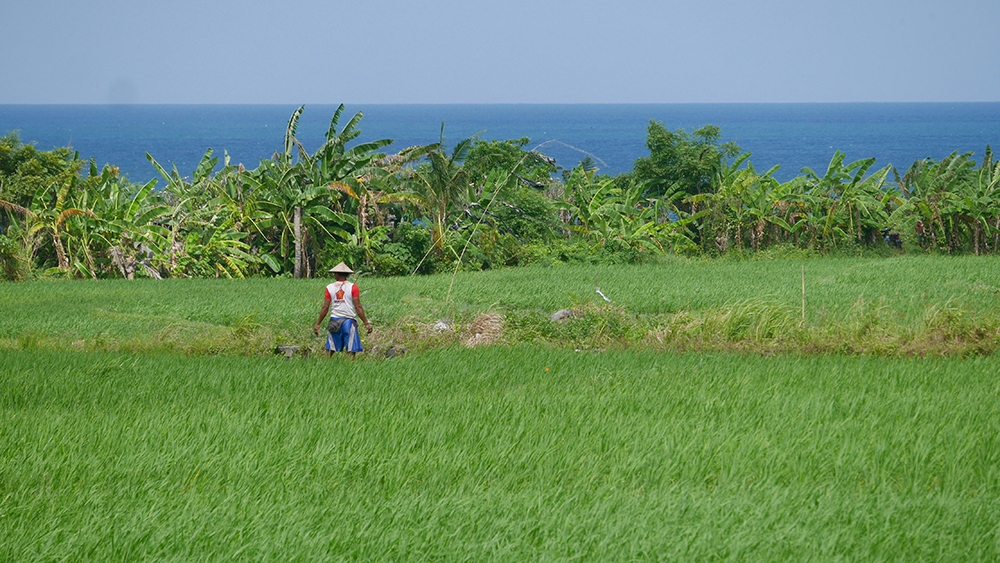
Surf camp Bali Kedungu Beach surf lesson Jambul
At the very first, before being known for his surf spot Kedungu Beach, the village was a small Balinese fishermen village.
Kedungu means crab, a kind of crab, well that’s what I’ve always thought, and you’ll see at the entrance of the village (or Banjar) a crab statue. Don’t expect a statue as high as Mount Agung, but it has been renovated a few years ago and locals put offerings at his feet everyday for protection. The statue is on your left at the main intersection of the village at the entrance of Kedungu.
However, in Bahasa Indonesia crab = kepiting … So why have I always heard that Kedungu means crab ?
Dusunku harapan masadepan
My village hopes for the future

Kedungu beach bali by Jambul
I went and talked to my grandpa’s cousin to have some stories , info and legends about Kedungu. Here’s what he told me :
A legend says at the beginning, around 20/30 persons were living in the village. They were all fishermen and the villagers had 10 Bangsal at the beach, a kind of boat garage, nowadays only one left at Kedungu Beach. Each Bangsal had two or three Jukung (Bali traditional fishing boat). The ocean was so full of food, locals were not fishing for eating anymore, but they started to sell them. It continued like that for a while, villagers had more and more fishes, crabs and lobsters … so much that one day they did not know what to do anymore with it. They had enough food, and they could not sell more. So they let them on the sand , tons of fish on the sand, for … well long enough to make the fish so rotten that the whole village was stinky. Stinky or bengu in Bahasa Bali (Do you feel it coming ?)
Actually this stinky episode made villagers realized that not everybody could be fishermen so some locals started to bake and created Klepon. A lot of people around Bali liked Klepon, they came to Kedungu to buy first, then learn the recipe of the famous cake.
« The recipe of Klepon spread really fast, as fast as a group of crabs when they run in all directions. »
The leader of the village at the time decided to name the village after this event, the memory of the «bengu» episode plus the spread of the Klepon recipe as a crab movement created KEDUNGU. He used the end of bengu (stinky) and put something that sounds fun in front.
That’s why he made a statue at the entrance of the village, most of people will see a crab only, but at its feet there is also a basket full of Klepon! (…yes check it again)
My parents continue the tradition and are baking Klepon every day and sell them around Bali. They are boiled balls made from rice flour, coconut sugar, coconut flakes and have this super bright green color. Don’t be scared, it’s natural ( well my parents ones are), the color is made from daun suji ( suji leaves ).
Fishing in Kedungu beach
You’ll still see a lot of fishermen in Kedungu, they have their own community in the village. Local fishes, crabs, lobster, shells, seaweed, sea urchins, … you can find a lot of things in Kedungu Beach. Most of the fishermen are nowadays living from selling lobster around the island. Some boats are sailed at the end of the river and you can see them (and help them too) pulling in or out their boats every day in the ocean. They often give some fish compensation to the helpers.

Subak & Ricefields in the village
Every village in Bali who has rice fields has a Subak: the water management system (irrigation). Developed during the 9th century, the Subak system is more than providing water to the fields: Balinese built a complex pulsed artificial terraced ecosystem.
On 6 July, 2012, subak was enlisted as a UNESCO world heritage site as Cultural Landscape of Bali Province: the Subak System as a Manifestation of the Tri Hita Karana Philosophy (or the balanced relationship between humans, earth and gods).
Also in our beautiful Tabanan Regency opened in 1981 the Subak Museum.

Temples in Kedungu
As Kedungu village is part of Desa Belalang, it belongs to its Khayangan Tiga, a group of 3 main protectors temples of the villages. The three temples are located on the East side of the village , between Belalang and Kedungu.
We can count 7 more main temples in Kedungu (and I don’t even talk about family temples, all the small rice fields temples,….)
- The Banjar temple
This is the protector of the neighborhood.
Dalem Segara
The sea temple, located by the sea to appease the sea Gods and deities. Famous example of this type of temple is Pura Tanah Lot .
- Bendego Temple
Located at the beach, this is the temple protector of fishermen
- 3 Beji Temple
The pure water temple. There is one big source in Kedungu and two small ones. Each source has its own temple. It says the water is drinkable, naturally filtered by the stones.
- Dugul Temple
Protector of the rice fields. Well there is so many small rice fields temples, and 1 big one.
Who knew all this about Kedungu village ?
It is not easy to collect information as nothing is written, here history goes from mouth to ear. Theses stories are from my grandpa’s cousin, I hope you enjoyed reading this article, and maybe you’ve learned some news things ?
See you soon in Kedungu
Jambul
